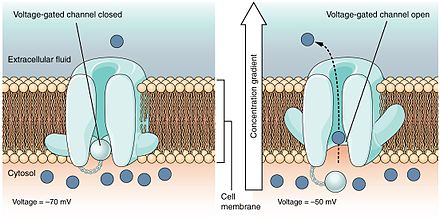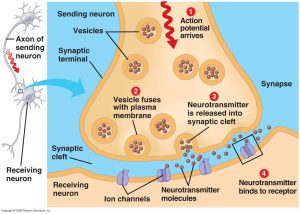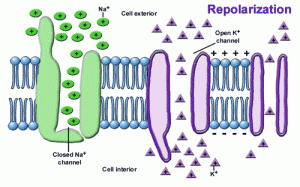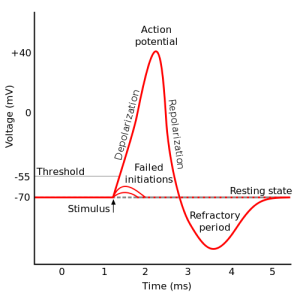Nerve impulses consist of action potentials fired in neurons. Understanding the process of firing and recovering from an action potential is necessary to understanding nerve signaling. This summary divides the action potential into stages, found below. Follow the links below to the Glossary for questions about unknown terms.
Before the action potential:
- The neuron stays at a resting membrane potential of -70 mV.

(“Membrane potential,” 2004)
- The neuron receives signals via its dendrites.
- Signals that fail to raise the potential to the threshold potential cause no change.
The start of the action potential:
- An incoming signal reaches threshold and opens the first set of voltage-gated sodium channels.
- Positively-charged sodium pours into the cell, causing depolarization.

(“Voltage-gated channels,” 2016)
- Depolarization in the first region causes the second set of sodium-channels to be depolarized to threshold.

(“Action Potential,” 2013)
- These and subsequent sodium channels open due to positive feedback in a wave down the axon.
The end of the action potential:
- The action potential reaches the axon terminal.
- This signals neurotransmitter to be launched into the synaptic cleft.
- The neurotransmitter diffuses across the gap to bind to receptor proteins on the next cell.

(“Nervous system”)
Recovering from the action potential:
- Once the neuron depolarizes to about +30 mV, the cell begins repolarization.
- Sodium channels close and potassium channels open.
- Positively-charged potassium leaves the cell, causing the potential to decrease.

(“Repolarization”)
- Sodium channels are inactivated during repolarization so an action potential can’t re-fire.
- The potassium exiting the cell will drive the membrane potential down to about -80 mV.
Returning to resting membrane potential:
- Driving down past resting potential causes hyperpolarization.

(“Action potential”)
- Sodium channels can now be reopened, but it is more difficult.
- A new signal must overcome the potential from threshold to resting plus the additional hyperpolarized potential.
- Sodium-potassium pumps and natural diffusion bring the cell back to resting potential.

(“Refractory period”)
From the resting membrane potential, this process may repeat as the neuron receives new stimuli. To learn more about the process of beginning and transmitting a signal along a neuron, there is a video on the next tab and the Glossary of Terms contains more thorough definitions of the individual components described here. To test your knowledge of the nerve impulse, go to the Quiz tab.